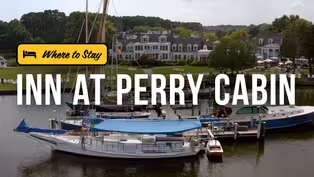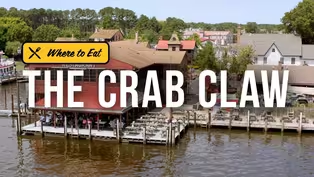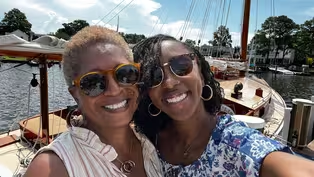Get Out of Town
The Chesapeake Bay Maritime Museum Brings History to Life
Clip: Season 1 Episode 3 | 4m 56sVideo has Closed Captions
Lauren and Laurita pay a visit to the Chesapeake Bay Maritime Museum.
Lauren and Laurita pay a visit to the Chesapeake Bay Maritime Museum in St. Michaels, Maryland, an interactive and experiential learning venue dedicated to showcasing the Chesapeake Bay's history, culture, and environment. The Portees learn all about St. Michaels' past as a shipbuilding and oyster harvesting town, and try their hand at oyster tonging. It's harder than it looks!
Problems playing video? | Closed Captioning Feedback
Problems playing video? | Closed Captioning Feedback
Get Out of Town is a local public television program presented by WETA
Get Out of Town
The Chesapeake Bay Maritime Museum Brings History to Life
Clip: Season 1 Episode 3 | 4m 56sVideo has Closed Captions
Lauren and Laurita pay a visit to the Chesapeake Bay Maritime Museum in St. Michaels, Maryland, an interactive and experiential learning venue dedicated to showcasing the Chesapeake Bay's history, culture, and environment. The Portees learn all about St. Michaels' past as a shipbuilding and oyster harvesting town, and try their hand at oyster tonging. It's harder than it looks!
Problems playing video? | Closed Captioning Feedback
How to Watch Get Out of Town
Get Out of Town is available to stream on pbs.org and the free PBS App, available on iPhone, Apple TV, Android TV, Android smartphones, Amazon Fire TV, Amazon Fire Tablet, Roku, Samsung Smart TV, and Vizio.
Providing Support for PBS.org
Learn Moreabout PBS online sponsorshipWe finally made it to our first stop.
LAUREN: The Chesapeake Bay Maritime Museum.
LAURITA: So now, it's time for a little history.
LAUREN: Woo-hoo.
Mom, these are not instructions.
This is just a picture of the knot.
LAURITA: Hey, go for it, sister.
I don't know what to do.
LAUREN: Okay.
LAURITA: Okay.
FRANK: We are here at the Chesapeake Bay Maritime Museum in St. Michaels, Maryland.
It's 18 acres outdoors on the waterfront.
It's experiential.
It's interactive.
There is something for everybody.
You can't come to the Maritime Museum without having some level of learning, education and appreciation for how fragile and important the Chesapeake Bay is to all of our livelihood.
LAURITA: Female.
LLOYD: That's a female.
LAURITA: Yeah, sure is kickin'.
LLOYD: That's right.
It's a female crab.
LAURITA: She is kickin'.
LLOYD: She's gonna go quick.
LAURITA: Ooh.
LLOYD: There she goes.
These guys might be too big to... LAUREN: Ooh, he's big.
LAURITA: Ooh.
LAUREN: He's a big one.
LLOYD: He's a big guy.
LAUREN: Ooh, he's big guy.
LLOYD: Yeah, he's probably about three to four years old.
That's about... LAUREN: Goodness gracious.
LLOYD: As big as they get.
FRANK: The Chesapeake Bay is actually an estuary.
It's about 180 miles long.
Technically, this is called the Miles River, which opens up to the complete Chesapeake Bay.
The shipyard is the star of the show.
We have the world's largest collection of Chesapeake boats.
All these boats right behind me, 1912, 1931, these are all historic, authentic vessels.
And the shipyard's primary job is to maintain all these vessels.
This is an ongoing, living, breathing system.
The town of St. Michaels started really as a shipbuilding town, and it had a wonderful run of doing that.
But after the War of 1812, the shipbuilding industry died.
And after the Civil War, technology changed St. Michaels.
One of them is a skipjack.
These are oyster dredgers.
So the Chesapeake Bay is filled with oysters, and they were taking them out a few at a time by tonging, like a little, like a scissors.
The oyster dredgers could get hundreds and hundreds of oysters from the bottom of the bay and bring them in.
So all of a sudden, they had this bounty.
So that was the first technology.
LLOYD: So what I have here is a pair of oyster tongs.
Now, these are sort of made for the museum.
They're a lot smaller than what you find on a boat.
LAUREN: M'kay.
LLOYD: Because our oyster bed is right out here off the dock.
LAUREN: Oh, wow.
Oh.
LLOYD: Send it down, right down to the, to the bottom.
LAUREN: Send it down.
LLOYD: That's right.
LAUREN: Okay.
LLOYD: Now, open 'em up.
LAUREN: This way?
LLOYD: No, the... Yeah that...
Put your hands that way, that's right.
LAUREN: Got it.
LLOYD: Open 'em up and kinda rake 'em in.
Make sure you go... LAUREN: I feel like I'm not getting anything.
LLOYD: Put in straight.
LAUREN: There we go.
LLOYD: Okay.
Now, hold it hand... And bring it about hand over hand.
Keep comin', keep comin'.
LAURITA: Come on, girl.
LLOYD: Keep comin'.
LAURITA: Oh.
LAUREN: Oh no, they fell.
That was close.
LLOYD: You ever, you ever been in amusement park where you... LAUREN: Yeah.
LLOYD: Put the quarter in the machine and it close... LAURITA: Yes.
LAUREN: Yeah.
LAUREN: That was that.
LLOYD: That's what it's like.
LAUREN: That was exactly that.
LLOYD: That's what it was like.
Okay, let's try it again.
Keep comin', keep comin'.
Yes.
LAURITA: Oh.
I think I probably dropped the money one.
LAUREN: What'd you get?
Look at your treasures.
LAURITA: It's just shells.
LLOYD: Well, wait a minute, I...
There's oysters on that.
LAURITA: Whoo.
LLOYD: You got oysters.
LAUREN: Woo-hoo.
LLOYD: Now, that's called a cult.
That's how oysters grow.
LAURITA: Uh-huh.
LLOYD: They all grow together in a clump.
LAURITA: Nice.
Yes.
LLOYD: But you have, you have oysters.
You have about one, two, maybe three oysters.
LAUREN: Oh, that's cool.
LAURITA: Yes.
Look at me with the oysters.
LLOYD: That's right, that's right.
LAURITA: I'll see you later for dinner.
LAUREN: Oh!
LLOYD: Okay.
(laughs).
FRANK: They would dredge the oysters.
They'd bring 'em to a packing house.
They would shuck the oysters.
They'd put 'em in a gallon can, seal it, put it on ice.
They'd put it on a train.
It would go to New York, Chicago, Philadelphia.
So the whole oyster business exploded, and so St. Michaels had this renaissance of seafood harvesting and packing and so forth.
And then we had a problem; the oyster population declined significantly, and this campus here was not good business.
So the Historical Society of Talbot County started to acquire historic buildings, which are part of the museum now.
And in 1965, they opened the Chesapeake Bay Maritime Museum.
It's funny.
You'd say, "Well, why do you go to a museum?"
And I answer that in one word, fun.
The Inn at Perry Cabin Isn't Just for Wedding Crashers
Video has Closed Captions
Clip: S1 Ep3 | 4m 3s | Lauren and Laurita explore the luxurious accommodations at The Inn at Perry Cabin. (4m 3s)
Locally Sourced Seafood is a Way of Life at The Crab Claw
Video has Closed Captions
Clip: S1 Ep3 | 3m 40s | Laurita and Lauren enjoy picking crabs at The Crab Claw in St. Michaels, MD. (3m 40s)
Preview: S1 Ep3 | 30s | Laurita and Lauren take to the water in the seaport town of St. Michaels, Maryland. (30s)
Providing Support for PBS.org
Learn Moreabout PBS online sponsorshipSupport for PBS provided by:
Get Out of Town is a local public television program presented by WETA
















